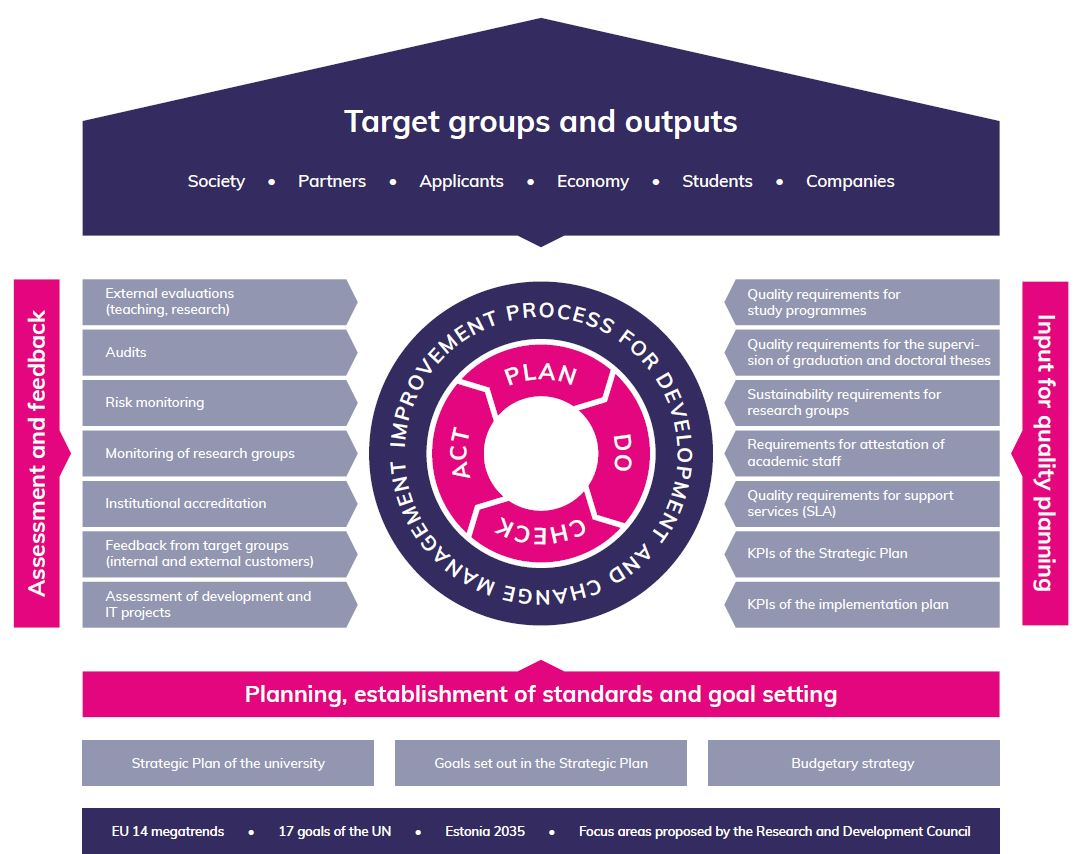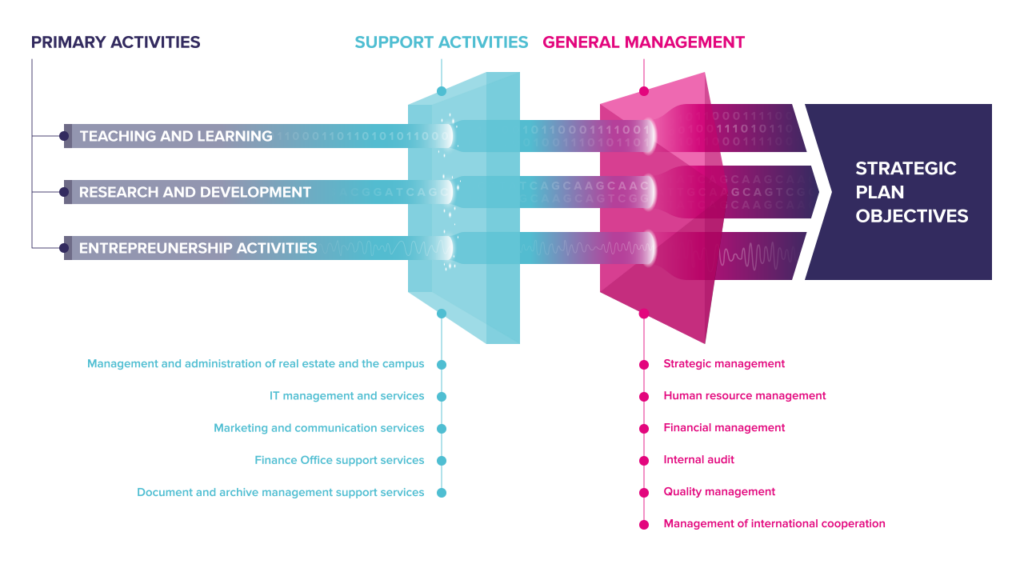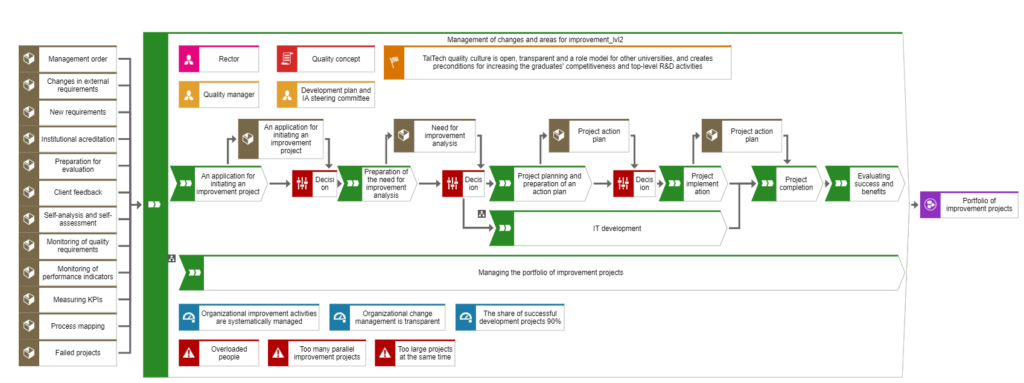The directive is issued based on clause 12) of § 11 of the Statutes.
1. I approve the Quality Concept of Tallinn University of Technology (attached).
2. The quality concept shall be applied in regulating, developing and changing the university’s support processes.
3. I repeal TUT Management System Manual (approved by directive No 94 of 20.06.2016, amended by directive No 53 of 25.11.2019).
Quality Concept of Tallinn University of Technology
TABLE OF CONTENTS
QUALITY CONCEPT OF TALLINN UNIVERSITY OF TECHNOLOGY
- Quality
- Quality management principles
- Organisational structure
- Liability
- Key components of the monitoring system
- Management of the developments and changes of administrative support processes
QUALITY CONCEPT OF TALLINN UNIVERSITY OF TECHNOLOGY¹
1. QUALITY
Quality is the basis of an organisation’s management culture. Quality is a mindset implemented by each manager and staff member. The Rector and the Rectorate take the lead in the development of quality culture. The heads of all structural units bring quality culture to each staff member. We expect each staff member to act in accordance with the university’s quality agreements and processes. Each member of the university community shall perform its work and make its choices based on the core values of the university. The university carries out its activities in compliance with the Academic Strategic Plan, the university’s Strategic Plan, its implementation plan and the goals set out in them. The Quality Manager monitors purposefulness of actions, assesses the effectiveness of monitoring mechanisms and observes the performance indicators and metrics. The Quality Manager verifies consistency of the activities with the quality concept, the university’s Strategic Plan and its implementation plan and, where necessary, initiates corrective actions or changes. The Business Architect monitors
FIGURE 12: GENERAL MODEL OF THE UNIVERSITY’S QUALITY SYSTEM
optimality, synergy and integrity of the university’s processes. The Business Architect helps plan process-based structural changes and manages process mapping. The Business Architect is the owner of the interactive handbook SMART.taltech.ee. The quality system consists of various external and internal requirements set out based on the goals and long-term targets laid down in the university’s Strategic Plan and is improved through regular self-assessments and external evaluations. The requirements for study programmes, the requirements for attestation of academic staff, the quality requirements for support services, etc. provide an important input (quality requirements and definitions) for the quality system. The key quality monitoring mechanisms include external evaluations, audits, feedback from various target groups, regular monitoring, etc. When implementing corrective actions, it is crucial to complete the general management cycle (PDCA) that solidifies the principles of quality culture.
2. QUALITY MANAGEMENT PRINCIPLES
• User-oriented (target-group-oriented) and focused on the primary activities – the university’s activities are focused on the achievement of the targets and goals of the primary activities, while taking into account the expectations and needs of the external and internal stakeholders3 of the university. The administrative and support structure of the university supports the achievement of the goals of the primary activities;
• Clarity and transparency – the university pursues clarity and transparency in responsibilities, goals, expectations, management structure, hierarchical relationships, roles and performance/quality indicators. Quality agreements regarding processes and services have been concluded between the owner and the end user;
• Synergy – the university is seamlessly operating, user-oriented, interoperating and interacting across all structural units;
• Viability and sustainability – the university’s activities are optimised and resource-efficient, avoiding duplication and fragmentation, responsive to feedback, innovative and constantly improving over time;
• The once-only principle – services are provided on the principle that data is requested once and there is a single contact point in each sector;
• Evaluating effectiveness – when planning changes and development, the activities and projects are evaluated based on the extent of their impact on the achievement of the strategic goals.
3. ORGANISATIONAL STRUCTURE
The organisation of the university consists of academic and non-academic units. The activities of all units are supported by different processes. The activities of the organisation are divided into: primary activities, general management activities and support activities.
• A primary process is a set of various activities and tasks, the aim of which is the actual implementation of the university’s primary activities. The customers of the primary processes are the target groups from outside the university – entrants, students, alumni, partner universities, partner enterprises, organisations and society at large. There are three primary activities at Tallinn University of Technology: research and development, teaching and learning and business (incl. knowledge transfer). The university-wide organisation of the primary processes is managed by the Vice-Rectors through their central units (the Research Administration Office, the Office of Academic Affairs, the Technology Transfer Office) constituting the units supporting the primary activities.
• The university’s general management and/or horizontal processes, resources, services and projects are managed via management processes. Management processes include for example strategic management, quality management, policy making, international cooperation, human resource management, etc.
• Support processes are designed to support and enhance implementation of the primary and management processes. The partners in support activities are target groups within the university – either an academic unit and/or support unit, depending on the process, and its staff. The conventional support processes are real estate management and administration, accounting, IT management and support, document management, etc.
FIGURE 2. OVERVIEW OF THE PROCESSES
All the university’s processes are included in the interactive handbook, which is updated from time to time. The processes are related to the university’s Strategic Plan and its key indicators, as well as the implementation plan and its metrics. Besides the key indicators, the metrics and process goals, the risks and regulations associated with the process, as well as the owner and manager of the process are described on each process map.
The organisational structure of the university is process-based
• A process map has been created for each major process (see 4). The following is indicated on a process map:
-
-
- the process owner and manager;
- the acts governing the process (laws, standards, rules, principles, legislation, etc.);
- the strategic goal of the process in the Strategic Plan or its implementation plan;
- the main workflow of the process;
- the most important inputs and outputs of the process;
- the (internal and external) target groups;
- the services provided in the framework of the process;
- the performance indicators, activity indicators and quality or compliance indicators;
- risks.
-
4. LIABILITY
For seamless functioning of the organisation and in order to provide high-quality services supporting the primary activities, it is essential to determine the process owners and managers and their liability, which is a prerequisite for the interaction of different processes.
TABLE 2: LIABILITY OF THE OWNER AND MANAGER
| ROLE | LIABILITY |
|
Process and/or service owner |
• Approves the goal(s) of the process and sector
• Approves the standards, quality requirements and indicators • Ensures the resources required and participates in agreeing the funding model • Sets priorities in line with the strategic priorities • Approves the goals of the process/service, the benefits and measurable results, initiates changes, if necessary • Resolves problems and conflicts |
|
Head of the sector (head of a department, structural unit or team)
|
• Formulates the goals of the sector and its processes/services and submits them to the owner for approval
• Is responsible for the interaction, consistency and updating of different processes in the sector • Makes sure that the outputs of the process or project meet the organisation’s goals, priorities, and user needs and expectations. • Is responsible for successful performance of the project(s) related to the process. • Shall regularly inform the owner of the progress and risks or hindrances. • Is responsible for risk mapping and management. • Initiates and launches corrective actions (incl. IT developments) in coordination with users and the owner. • Informs the related parties of changes. • Determines the resources required for the project – the budget and the team. |
|
Process/service (incl. project) manager |
• Leads and develops the process • Sets out the process standard(s) in coordination with the beneficiaries (incl. develops and establishes measurement and feedback systems). • Evaluates quality regularly. • Conducts user/target group feedback surveys and initiates corrective actions. • Manages various process-related development projects (incl. work arrangements + IT) • Formulates process/service success criteria and indicators. • Informs the parties involved of the changes • Launches projects for changes/corrective actions (the prerequisite is an approved goal, benefit and results, availability of resources and a team). • Plans and manages any necessary operational restructuring and organisational changes, ensuring that the organisation is ready to apply the outputs of the changes/ developments. • Keeps all of the documentation updated. • Ensures the success of services/processes/projects or informs about risks and hindrances. |
5. KEY COMPONENTS OF THE MONITORING SYSTEM
The monitoring system consists of a set of components, which operate on the same principles, but can be observed independently.
• Review by the Council – once a year, after the summaries of the annual review
-
- Achievement of the key performance indicators and implementation of the Strategic Plan (incl. the key indicators of the implementation plan);
- Risk mapping and management
• Annual review by the management (March-April)
-
- Annual review – budget implementation report, annual report (incl. activity reports by field);
- Academic dialogue with Schools once a year to review performance agreements;
- Monitoring of the key indicators of the Strategic Plan and metrics of the implementation plan;
- Monitoring of research groups (a research group passport);
- Monitoring of study programmes, incl. tracking the progress/dropout rate (at BA level) and graduation rate of first-year students;
- Monitoring of the quality requirements for study programmes;
- Feedback from target groups (staff, students, alumni, employers, …);
- Risk monitoring
• Attestation – on an on-going basis in accordance with the individual cycle of an academic career
• Annual audits according to the audit plan
• Information security review according to the action plan
• Feedback on services – the system of feedback on services includes either user surveys, customer surveys or regular monitoring of feedback on services provided by various target groups. As a rule, a 10-point rating scale is used for feedback; feedback is collected regularly and, if necessary, the topic of feedback is adjusted in accordance with the improvement project on the agenda4.
A monitoring period consists of the preparation period, data collection, analysis and public disclosure of data.
FIGURE 3: ANNUAL CALENDAR OF THE UNIVERSITY’S MONITORING SYSTEM
6. MANAGEMENT OF THE DEVELOPMENT AND CHANGES OF ADMINISTRATIVE SUPPORT PROCESSES
The university’s support and management processes enhance the primary activities and form an interoperative administrative support organisation. Regular feedback collection and monitoring of the university’s processes and services is carried out, corrective actions are implemented and follow-up evaluation is conducted.
The quality concept is the basis for organising, developing and making changes in support activities and services.
A consolidated process is used for the implementation of the university’s development projects, IT projects and changes, where the following general principles shall be followed:
− the logic of the general management cycle (PDCA) shall be applied;
− corrective actions are agreed with both the main beneficiary (e.g. through a control group) and the owner;
− when a project is initiated, its goal, measurable results and benefits are considered and formulated; it is recommended to complete an initiative proposal before initiating and planning a project;
− at the end of a project, the success of the project is measured (adherence to the budget and planned schedule, achievement of the goals).
FIGURE 4: MANAGEMENT OF CHANGES AND AREAS FOR IMPROVEMENT
The aim of the improvement of implementation of developments and changes is to increase the success of university projects (development projects, IT projects, change projects, implementation plan projects), to manage corrective actions systematically and changes transparently. The goal is a 90% share of successful projects.
Monitoring is carried out mainly by collecting feedback on the quality of services. Feedback is collected regularly and based on needs5. Feedback is collected from internal target groups (members) or external target groups (alumni, partner enterprises, etc.)
In order to prioritise and decide on the funding of development projects (incl. projects launched for the implementation of the Strategic Plan), the Rector hears the steering committee of the Strategic Plan.
——-
1 The quality concept is based on the university’s mission, vision, core values and the Strategic Plan.
2 The PDCA (plan-do-check-act) or general management cycle, the suitable definition in Estonian must be agreed. planeeri- tegutse-hinda-rakenda Terminology: see Üksvärav, R. (2008). Organisatsioon ja juhtimine (4 tr.). Tallinn: Press House of Tallinn University of Technology
3 External target groups are entrants, companies, partners and society at large. Internal target groups are students and either academic staff and/or support staff, depending on the process
4 The agreed satisfaction index is used.
5 For example, a new counselling service is being introduced for setting goals to projects and applying for project funding – the contact persons will be trained, a service will be developed for the network and feedback will be collected on the level of competence, speed and relevance of the service (when this part of the service is functioning, the process will proceed to the next stage; a follow-up check will be made at some point to make sure whether the service level still meets the expectations). A 10-point rating scale is used. The share of both satisfied and dissatisfied target groups is monitored.



